Lewis and I travelled around the globe to make our second visit to Spain. Our first visit to the kingdom occurred in 2011, and we went Madrid and Barcelona. This time, we explored deeper into the capital, and we ventured to Valencia. As travelers, we want to share our story to revive your spirit of exploration. So, please take your time and enjoy.
We flew aboard Iberia Airlines to get to the Iberian Peninsula, which has four nations: the Kingdom of Spain (its monarch is King Felipe VI), the Republic of Portugal, the Principality of Andorra (its monarchy is jointly-held by the Bishop of Urgell and the President of France), and the British Overseas Territory of Gibraltar (its monarch is King Charles III). [The British smugly retain Gibraltar since 1704 because it’s the closest port to the continent of Africa].
Each roundtrip ticket cost $639. For the second time since we got it, the "privilege" of buying (and qualifying for) TSA PreCheck was useless because the TSA allows airlines to ignore its status. That is idiotic. If America's federal government says that holders of PreCheck can bypass some Security Screenings, then that status should function at all of America's airports; it should not depend on the opinion of each airline. That is another example of "buy it now" scams... and overall ineffectiveness in this country. *Use this link to learn about the TSA:
https://halfwindsorfullthrottle.blogspot.com/2015/06/flying-failure.html
Our flight from New York City was only delayed by 45 minutes (that's sarcasm), thanks to unchanged inefficiency and uncaring employees at JFK Airport. But I won't delve into it because you probably noticed that I repeatedly described NYC's decrepitly-unfixed airports since my first blog entry in 2012. (11 years of crap is the level of non-improvement in the USA).
Iberia's priority is punctuality, so the pilots regained time, and we landed in Spain as scheduled. Iberia's biggest drawback is the cramped seating. Their lack of space was as bad as American carriers! My height is 6.1' and my knees touched the seat ahead of me.
When that person reclined, it put their headrest too close to my face. Elbow-room is also non-existent. (How do you make an aircraft without space for legs or arms?) On the outbound flight, I sat on the aisle, and flight attendants repeatedly banged into my elbow—which had few choices of positions—and never apologized. They didn't "bump into"; they "banged into". My elbow didn't block their way, and they had plenty of space to pass. It seemed that they did it purposely to make passengers tuck their arms into their undersized seats. On the return flight, Lewis sat on the aisle, and had the same rude encounters, as they banged into his arm. Therefore, despite the decent food and wine (no hot beverages because they expected turbulence), and punctuality, we will never purchase tickets with Iberia again. As you'll see in the reviews below, other travelers dislike them due those unchanged issues. (Click on any image to make it bigger/clearer)...
Making it worse, the service is lackluster. Half of the crew seemed impatient to conclude their tasks without niceties. (Sorry if we bothered them by buying tickets on their flight). During dinner on the return flight, I asked the man pushing the drink trolley for a second bottle of white wine. He replied, "I don't have any, but I can get it for you. But, if I forget, you can get it yourself." He forgot my request. Considering that I was in the middle section of the aircraft, with a person on either side of me... his remark wasn't helpful. Thanks.
We never intended to use Iberia; we bought our tickets from British Airways. But, due to a convoluted "partnering scheme", BA sold us the tickets (Lewis got the air-mile points), but we flew aboard an Iberia plane. That's like entering a BMW dealership to buy a car, but they give you a Hyundai.
After 8 hours that lacked legroom and arm-space, our jet arrived in the Kingdom of Spain. This is its flag.
We disembarked at Madrid-Barajas Airport. Its initials are MAD, but the people aren't mad or angry. Ha ha! It's a beautiful facility that makes flyers feel lighthearted and airy. We needed that sensation after our cramped experience.
The airport began in 1927, yet it was refurbished and improved during the decades, whereas nothing substantial occurred at NYC's languishing airports since 1975. It is Europe's second-largest and fifth-busiest airport, yet it remains tidy and orderly.
It is situated in the Community of Madrid, which sounds cozily-small, but it is one of 17 "states/provinces" in Spain.
It's capital is also the national capital: Madrid. That was our destination. Soon after our arrival, T-Mobile provided me with quick service so I could make calls and communicate with people around the world.
Expecting to pay with cash at Spain's world-famous Tapas Bars and Wine Bars (cute stalls—not the snooty/overpriced Wine Bars that you see in the USA), we did a Currency Exchange. As part of the European Union, Spain's money is the Euro, yet it uses its own motifs for coins and bills.
The airport is huge. Travelers use a subterranean tramway to get between Terminal 4S and Terminal 4. Nothing like that exists at JFK. It's fully automated, and the platforms have glass walls to keep people/debris off the tracks.
Like any first-world city (outside of America), the airport is connected to the city-center by train.
However, we discovered a new experience that we decided to try, and it was recommended by the airport's website. The name of the company is Welcome Pickups, and it provides a chauffeured drive from airports and train stations to anywhere in the city.
The webpage is easy to navigate, and every car is guaranteed to be clean and disinfected before you enter. Drivers are required to use 20 minutes between customers to clean their vehicles. (That will never happen in the USA). Anticipating possible delays of their customers, drivers wait for 60-minutes at airports and 30-minutes at train stations. After that, there is an additional cost, unless you contact them to reschedule. We chose a route from the airport to Madrid's central train station (so we could purchase Transit Cards). The ride required 30 minutes, and it cost €35.00 for two passengers with two suitcases. That's excellent. (Taxi rides from JFK to our condo cost at least $50 for 30-minutes, and the taxis are usually unclean, smelly, and the drivers are gruffly unhelpful).
A day before our flight, we received an email that gave us an image of our driver, his name (Pelayo), the type of car, and it informed us that he would be waiting at the Arrivals Gate with a sign that had our names. As soon as we got to the Arrivals Gate, I phoned Pelayo, and he told us where he was. Politely, he took our suitcases and loaded them into his Peugeot 508 SW sedan.
*I must compliment MAD for its fully-enclosed Arrivals Area that covers six lands and a parking area! JFK has nothing like it.
The 508-model is a spacious car, and "SW" indicate a station-wagon. The sporty-sleek car looked like this...
...and it was nicer than any car that Uber or Lyft provided us during the entire year. Very nice! Our driver politely offered us bottles of water. We were comfy on the wide (clean) seat.
It also had a glass roof, which was lovely to enjoy.
It made our arrival into Madrid prettier. This is its coat of arms since 1222.
*Used with civic pride, we saw it often on municipal fixtures...
Drivers from Welcome Pickups pride themselves on being locals who share knowledge about their cities, and they happily answer questions. Pelayo gave us suggestions about how to do things as locals do. Spain has a non-tipping culture, so gratuities were never expected or requested. (Spaniards are paid livable wages and receive Universal Healthcare from their government, so they don't rely on tips. They truly live in a first-world nation; Americans don't). He did his job well—and gave extra niceties—because it's the right way to behave.
We loved the city's infrastructure of tunnels that allowed traffic to go under historic districts (with tight streets), and that prevented congestion aboveground.
*During our time in Madrid, we noticed many underground parking areas, which kept the streets tidy and kept cars clean from the weather. It reminded us of Amsterdam and Oslo. Most American cities lack that.
Our modern car zoomed around a traffic-roundabout at the Plaza of Emperor Charles V, and it arrived at Madrid Atocha Station. We waved Goodbye to our driver and entered the grandly-proportioned station. Trains use a newer/bigger concourse, so the historic one was repurposed for a botanical garden that everybody can enjoy as an urban oasis. Life-Work Balance. (NYC would greedily put an arena there).
Brainwashed from their "car culture", Americans may want to drive themselves everywhere... but cars are not needed. It is better to use the marvelous public transit and your own two feet.
From Madrid's transit website, I knew that renovations at the station prevented the Metro from stopping there, but I expected to be able to buy Transit Cards there. Uniformed employees told us that we could not; we had to go across the street/plaza to the next Metro station. There, a uniformed woman politely exited her (modern) booth and assisted us at the ticket machine.
We shared one Transit Card and used it for tap-and-go access. Buying the card cost €2.50. Oddly, passengers cannot buy daily, weekly, or monthly time-allotments for unlimited rides. They can only buy a quantity of rides: 5 or 10 at a time. For €6.10, we got 10 rides. That allowed Lewis and I to use the transit system 5 times, and then we needed to buy more rides and have them loaded onto the card.
Thankfully, our hotel was merely two streets north of the Metro Station, on the same road: Calle de Atocha. (Calle means "Street"). It existed since the 1500s as the weekly route used by monarchs going to the Sanctuary of Atocha for prayers.
(The street and train station are named for that sanctuary).
We instantly noticed a mix of clothes; some folks wore autumnal outfits but other people still had shorts and short-sleeved shirts.
Spain shares a similar latitude with New York, but it has a warmer climate than NYC's very cold and windy autumns. When we left NYC, the temperature was only 46-degrees Fahrenheit (in Europe, that equals 7.7-degrees Celsius).
We quickly arrived at Axel Hotel. It's a boutique hotel in a historic building in the Centro District, which is the oldest of 21 districts with borders that remain from the ancient walls that encircled Madrid.
Lewis made our arrangements via Booking.com, and his status prompted the hotel to give us a free room upgrade. Very nice. The hotel was listed as "Adults Only", which was okay with us because it guaranteed a pleasurable time away from infants and families with kids. It describes itself as "heterosexual-friendly", which is another way of saying that it's "gay-friendly". Here are images from its social media pages...
[Homosexuality was decriminalized in 1979. (That didn't happen in the USA until decades later in 2003, even thought the USA pretends to be a nation of freedom and equality). During the ancient Roman era, same-sex intimacy was commonplace in Spain, and men got married. When Catholicism arrived in the 300s, it Christianized two Roman emperors, Constantius II and Constans, and laws against homosexuality began. In 1994, same-sex partnerships were official, and same-sex marriages and adoption were legalized in 2005 (2015 in the USA). Spain is regarded as one of the most culturally liberal and LGBT-friendly nations in the world. Madrid’s annual Pride Parade is spectacular].
The hotel employees were infatuated to discover that we were New Yorkers...
... and we were given Free Cocktail coupons to use at the rooftop swimming pool (open day and night)...
...and we were invited to attend that night's Erotic Comedy Show in the lower-level lounge.
Full of thoughtfulness, they provided a condom for each of us.
As the days progressed, our hotel staff became fond of us. We had the effervescence of New Yorkers without the rudeness. Colloquially, guirir is the Spanish word for a foreigner whose appearance identifies them as a tourist. Cañero is the slang word for people who are "loud and fast" (like Trump and over-rushed Americans). Those words were never used for us! :-)
In Spanish, Lewis' name is "Luis". My named doesn't translate, so it remained as "Kenneth"; it originated with ancient Gaels to mean "handsome lord born of fire". "Lewis" has Frankish-Germanic origins to mean "loot-carrying warrior".
Activated by our room-cards, the elevator took us up. Our deluxe room had plenty of towels, terrycloth bathrobes, slippers, dental kits, nice soaps, stemware, fully-stocked fridge, electric teapot, and lots of lighting options. A see-through shower was beside a toilet room. Our balcony overlooked the street.
Red velvet drapes, sheer black lace curtains, black-and-white bathroom tiles, a neon sign, and sleek furniture on a hardwood floor made the room stylish. Lewis phoned the Front Desk for more soap and shampoo, and a young bookishly-cute fellow (with pointy Drag-Queen fingernails) came with an armload of soap, shampoo, conditioner, and lotion bottles. Sheepishly, he admitted that he forgot what we requested, so he gave us plenty of everything. Four nights at the Axel Hotel cost €625.62.
After showering, we headed into the city for lunch. Walking west, we admired the efficient centralized bus connections for several routes at Plaza de Jacinto Benavente. No traffic jams or angry horns... just seamless progress. Beautiful.
Firstly, buses in Madrid outclass NYC's crappy ones because they're manufactured by Mercedes-Benz. Secondly, they have electric engines that are whisper-quiet. Even the double-length buses barely make noise as they carry dozens of passengers across the city.
Please enjoy my quick video of their peaceful engines: they are so quiet that you don't notice they are there!
Compare that to the obscenely loud buses in NYC, with bad engines that go thundering down the streets like Soviet tanks. They seem to strain to do the job that they were built for, and that noise causes pedestrians to shout at each other to be heard.
We were also wowed to see mini buses. Developed for Spain's curvy medieval-era lanes, they use silent electric engines to maneuver through the city-center and provide transit service to places that bigger buses can't enter. Wonderful infrastructure!
The street from our hotel led straight to our destination. It was picturesque!
It was only a 10-minute walk to Plaza Mayor, which was surprisingly crowded on a Thursday afternoon.
It was created in 1580 as Madrid's main square and market area (while Spanish troops subjugated the Kingdom of Portugal and its territory of Brazil). It still has a 1616 bronze statue of King Philip III.
We already knew to bypass its eateries, which are "tourist traps". Instead, we chose the world-famous Mercado San Miguel.
We also knew to disregard the unreliability of Google Maps, which still said that the facility was Temporarily Closed.
(Goolge Maps malfunctioned and gave inaccurate information every day during our trip).
It was built in 1916, and it retains its iron/glass architecture. Indisputably, it's the most popular Tapas Market in the capital.
FYI: a "mercado" (market) in Spain is not a grocery market; it's a tapas market with various vendors selling an assortment of food. But you can buy things and take them home.
San Miguel has 30 vendors, yet their menus rarely overlap. Some specialize in seafood tapas, others sell beer or dispense champagne, and others proffer pork and ham. Baked goods (especially empanadas), olives, fruit glacé, and cocktails are part of the amalgamation. The Market of Saint Michael gets its name from a church that stood there in the 1200s.
I’ll explain the difference between this and what’s in NYC. Nothing like this exists in the vastness of NYC’s five boroughs, and NYC doesn’t care. To get something similar would only happen if money-hungry (and corporate-sponsored) “celebrity chefs” created a space. But, in that situation, every package of salami would cost $35, each glass of wine would be overpriced at $40, and each pastry would cost $20. That’s what happens at NYC’s Eataly and Chelsea Market. Lewis and I loved the Food Halls (Markets) in Copenhagen, London, Helsinki, Madrid, Jaipur, Shanghai, Beijing, Boston, Barcelona, Amsterdam, Halifax, Berlin, and Kyoto. Nothing like that exists in overpriced NYC. How can that be?
Lewis and I ate at the Mercado during our first visit, and memories remain vivid, so we returned. The food-stalls sell "small bites" that are intended to be eaten while standing, and customers usually get different things from several places. That is how the culture of a Food Market operates in Spain.
Spain’s cuisine upholds centuries of traditions and unique cookery, and you can sample all of it at that mercado! The kingdom is the world’s largest producer of olive oil. Rice was introduced from China via the Byzantine Empire in the 6th-century, and it remains a mainstay. When Arabs conquered the Iberian Peninsula, they improved irrigation to grow sugarcane, saffron, spinach, eggplant, and citrus fruits. Moorish people implemented the basis for making pastry-crust. Spaniards went to the Americas in 1492 and brought back new ingredients that were distributed across Europe: tomatoes, potatoes, corn, peppers, paprika, vanilla, and cocoa (for chocolate). Spain was the first nation to blend cocoa with sugar (both were expensively rare items) to make a delectable treat.
We bought fried seafood from one vendor, meat skewers from another, Aperol cocktails from a speciality stall, oysters from a different vendor, white wine from a bar, and empanadas from another place.
Vendors prefer credit card payments, and if you pay with cash, you can expect to receive your change in coins. (Coins have the King's image). This is the ninth year of the reign of King Felipe VI.
Unlike America's greedy schemes, credit cards in Europe don't demand extra fees from businesses, and they don't demand fees from credit card holders. So, they are popular forms of payment. But, if you bring an American Express card—which is notorious for the highest fees—some businesses might reject it. That's fair.
Being agile travelers, we quickly got acclimated to the routine of mealtimes in Spain. It has a rhythm that is similar to Italy, so its nuances are imperative. Spaniards begin with breakfast, followed by a smaller mid-morning "breakfast". Sensibly, lunch is the largest meal of the day because it fuels you for your activities. Dinnertime doesn't begin until 8pm (20:00), so people either pause at 4 o'clock for "pastry & coffee" or at 6 o'clock for "tapas & aperitifs" to whet their appetites. Cocktails are popular, but Spaniards retain their partiality for aperitifs and vermouths. Wine is sipped in the morning, during "quiet times" in the afternoon, and always with dinner. Dinner is smaller than lunch. A few hours after dinner, people go out to bistros, mercados, gastropubs, and cafes for "small bites" and to socialize. That usually begins at 10pm (22:00) and ends at 1 in the morning. The after-dinner routine amazed us! (That's also when people drink cocktails and brandies). Without wavering, it occurred every night that we were in Spain. A Tuesday night looked identical in vibrancy and frivolity as a Saturday night! At 11pm (23:00), we saw entire families, elderly friends, mothers with baby-carriages, and teens socializing together at mercados and cafes and going onwards to new eateries. It was marvelous.
Clearly, that is Life/Work Balance.
After lunch, we popped into Pasteleria Plaza Mayor, which was founded in 1790!
It is named for the main building in the Plaza Mayor, which was named Casa de la Panaderia. (Bakery House). (Built in 1619 as the city's main bakery, that building has the two angular towers that dominate the square). This sweetshop captured Lewis' attention because it sold violet cream liqueur. We bought a small bottle (and sipped it in the evening on our balcony). It was delicious, and we recommend it!
From there, we ambled to a supermarket named Dia, which was near our hotel on the same street. Typical of European grocery stores, everything was well-made and fair-priced. When a government provides Universal Healthcare to its people, that nation has priorities for wholesome food—with nutritious ingredients—and affordability to make it accessible. That's the opposite of the USA, which enriches corporate makers of "junk food" or innutritious "food products" that are manufactured with chemicals, growth hormones, and genetically-modified ingredients. (The USA is also one of the few nations in the world that keeps a "for-profit" healthcare system that enriches pharmaceuticals companies and beleaguers taxpayers with exorbitant medical insurance fees and overpriced treatments—which are rarely preventive). We prefer Europe's ideals that begin with wholesome food.
We bought snacks to have in our hotel: sheep's milk yogurt (€0.79), quart (liter) of organic orange juice (€2.79), wedge of pre-sliced Manchego cheese (€1.70), and bottles of wine that were all priced under €5.00! In America, wine that costs less than $15 is usually crap, but in Europe, well-made vintages only cost €1.79 or €4.49 per bottle. We love that. For some idiotic reason, supermarkets in New York are prevented from selling wine... so you pay more to live there for more inconvenience. We love Europe's affordability and sensibility at supermarkets!
Spain is a famous for its wines. Grapes grew there for 2.5 million years, and the first wineries began in 1100 BC. We got a bottle of Sauvignon Blanc produced in a wine-growing region named Valdepenas, located in the Province of the Royal City. The region was awarded with a protective Designation of Origin status by the European Union. We trust whatever has that logo because it's stringent for standards and quality.
Spain's Ministry of Agriculture and Fisheries (which we saw near the train station)...
... ensures that those products are legally mandated to preserve their recipes and methods. In this case, wines from Valdepenas cannot be compromised/cheapened to make more profit. They must maintain superior quality and only use raw materials originating in that region. No outside products can use that name. (That is the opposite of America, where false advertising is legal, inaccurate ingredient labels are legal, and scams occur daily when descriptions of "small-batch" and "artisanal" have no legal meaning. Manufacturers use foreign and chemical-derived ingredients to make cookies in Bangladesh but label them as Danish Butter Cookies). Within the kingdom, that Protected Designation status applies to olive oil, rice (for paella), pastries, cheese, butter, wine, honey, mollusks, cured ham, meats, and sausages. During our trip, we tasted all of those!
Lastly, we were impressed that cashiers are permitted to sit. You don't see that in America, where cashiers must stand inhumanely during their entire work-shift. Life/Work Balance.
We deposited our goodies in our hotel room and went out again. From the Anton Martin Metro station, we rode Route #1 north.
Begun in 1919, Madrid's Metro system puts NYC's dilapidated subway to shame by outclassing it with cleaner stations, modern trains, newer infrastructure, and speedier service.
Day or night, during our entire time in the city, its trains arrived within only two minutes of each other. For New Yorkers like us, that was remarkable! They were always clean, and they were modern. Currently, we pay twice as much to live in NYC, yet we are forced to use trains from 1974 because NYC uncaringly does not upgrade its entire fleet. It looks like this...
Without shuddering or stalling like NYC's, Madrid's modern train zoomed out of the station with a speed that we rarely see at home. Similar to many countries that we visited, Madrid's Metro trains are openly interconnected, so people can spread-out and avoid congestion.
NYC has the most-crowded trains in the world—with the worst delays in the world—yet it deliberately has trains that prevent movement between cars, and it makes it illegal to do so. Idiotic.
Another asset for Madrid is that—unlike NYC—trains don't share routes. #1 Trains only operate on Route #1. You never see #1 Trains running on the #3 Route—which is a problem that happens every week in New York and confuses riders.
We exited at Iglesia (Church) Station, which is near an old church. It was coincidental for our next destination.
From his online research, Lewis was curious to see a Buddhist temple in this mostly-Catholic nation. We went to the Fo Guang Shan Temple.
It is located on a street named for John of Austria: the half-brother of Spain's King Philip II, who served gloriously as an admiral before his death at age 31. He's seen below... and that is quite an outfit: armor, sheer leggings, and billowing breeches!
It is in a neighborhood named Trafalgar, in the Chamberi District. (In the 1700s, French soldiers from Chambery, France, camped there during their efforts to siege the city, so the area was named for them. Trafalgar was named for the Battle of Trafalgar, when Britain defeated Napoleon's navy near Spain).
Exuding hospitality, a young woman welcomed us. The monks were elsewhere, but she was a volunteer who could answer our questions. Nevertheless, Lewis spoke to her in Mandarin and said that we wanted to pay respect to Buddha and see the facility. She detected his American accent and was charmed that we traveled so far to see their facility. She was glad to give us a tour, and she ignited incense sticks for us to use to venerate Buddha in the main room.
I liked the door handles that were shaped as prayerful hand gestures. The young woman showed us the various deities who have areas in the temple, and she was proud of the books in the library—free for anyone to borrow. An "auntie" lady met us in the Gift Shop. The atmosphere was tidy, relaxed, humble, positive, and refreshing. We noticed several rings that featured swastika symbols.
Before the Nazis perverted them in 1930s Germany, those symbols existed for centuries as emblems of good luck. Many cultures resiliently use them and disregard that era of misuse; we saw them used proudly for good fortune in Japan, China, and India. Applause for that.
*To see when we explored the Fo Guang Shan Temple in London, please use this link... https://halfwindsorfullthrottle.blogspot.com/2022/09/our-return-to-london-uk-part-1-of-6.html
We were impressed that the temple was in a posh part of the capital because most Buddhist temples in NYC are downtown in the squalor of neglected old buildings. Trafalgar looked like this...
We strolled to the Sorolla Museum, which contains masterpieces by Spain's artistic genius: Joaquin Sorolla (born in 1863). The mansion was his home.
Alas, it was closed. We were annoyed because we checked its website beforehand, and nothing was mentioned about the abrupt closure. Nonetheless, we walked farther to the Lazaro Galdiano Museum. It's near the Embassy of Nepal and the Residence of the American Ambassador. The palatial mansion was built in 1903 for a Spanish art collector named José Lazaro Galdiano (born in 1862).
He willed it to the nation in 1947. Frustratingly, it was also closed... and no explanation was given on its webpage. Nothing was posted on its gates.
Seeing that we were on the poshest street for retailers, Calle de Serrano, we decided to go shopping. The tree-lined street is world-famous for flagship boutiques of luxury brands.
We entered a department store named El Corte Ingles (The English Cut), referring to English style that was admired during the 1880s.
We chatted with an employee who compared the company to Macy's in the USA. The store is okay, but our experiences at De Bijenkorf in Amsterdam, Illum in Copenhagen, Harrods in London, and KaDeWe in Berlin surpassed it.
Farther down the street, we entered LOEWE's global flagship store. It's a handsome boutique.
A greeter registered our names and politely explained that there was a queue to be assisted, yet we were invited to explore the store. We went down the spiral staircase to Menswear.
Lewis was on a mission to obtain one of the brand's iconic Puzzle Bags: a cross-body leather bag with geometric patterns.
He wanted a mini version.
The company was founded in 1846 in Madrid by a group of leather craftsmen headed by Enrique Loewe, who came from the Principality of Hesse in Germany. It remained popular with celebrities and dignitaries around the world. To recognize its superiority, King Alfonso XIII bestowed it with a Royal Warrant to be an official Purveyor to the Royal Household of Spain.
That is type of publicity that designers dream of!
*That king was so revered that the Spanish luxury automaker Hispano-Suiza created a model from 1911 to 1914 named for him.
A salesman named Joao appeared and welcomed us cordially. The company issues new uniforms for each season, and the current one included cropped chinos, an asymmetrical button-down shirt that resembled a tuxedo shirt (with wingtip collar and white panels in front), and each person's choice of footwear (but most were sneakers).
Unlike how many luxury brands in the USA forbid tattoos or piercings on their employees at flagship locations, the brands in Madrid's glitzy area allowed it. Nice. Our salesman had tattoos on his wrist and neck, and he wore earrings and a nose-piercing. He was chatty and detailed—especially when he discovered that we were from New York City. (People still believe that it's a mecca of fashion... but few things are designed or made there, and after Anna Wintour dies, it will only have overblown corporate expense accounts at the various fashion headquarters).
The young man stated that he was a native of Madrid, and he asked which parts of NYC we were from? Lewis answered that he was born/raised in Manhattan, and both of us currently lived in Astoria, Queens. The salesman didn't know Astoria, but he was excited to meet a Manhattanite. He quickly detected Lewis's affiliation with well-made fashion. He revved up with is description of the boutique, which the company's Creative Director, Jonathan Anderson (a gay man from Northern Ireland), styled personally. The space involved two historic buildings that were joined, and the construction involved a plethora of government permits and scrutinies because of Madrid's focus on historic preservation.
Finally, it was time for Lewis to choose a color for his bag. While the men deliberated, I requested a glass of water, and the salesman summoned an apron-wearing porter who presented a tray with a bottle and glass. He served the water, smiled at me, and disappeared through a hidden door. Quenching my thirst, I smiled as Lewis bought the last grey-colored mini bag in the country! He was happy to get it because the color is versatile.
The salesman summoned a sales assistant to complete the VAT Refund paperwork for Lewis. Due to modernization in the kingdom, Lewis merely had to scan the document at the airport's VAT kiosk, and the tax refund would automatically go to his credit card. Wow!
Since he seemed knowledgable, we asked him why the museums were closed? He explained that many places and offices are closed during November 9 because people honor the Virgin Mary, who is a patron saint of Madrid. That seemed illogical to us because holidays provided people with time to visit museums. Yet, Spain upholds Life/Work Balance, so museum employees are entitled to enjoy the holiday, too. To compensate for that bad news in his hometown, he amorously gave us suggestions for local hot-spots to enjoy during our visit. He told us to browse the terraced restaurants nearby on Calle de Jorge Juan. We thanked him and departed to do that.
My sweetheart observed that the benches had a diagonal style that complemented his new bag!
We also noticed a multitude of "street art" statues shaped like women with wide dresses.
Found throughout Madrid, the statues are styled by celebrities, but the shape is based on a figure in a 1656 painting of the royal family titled Las Meninas by Diego Veazquez. Seen below, it hangs in the Museo del Prado.
Next, we entered a chocolate shop named Bomboneria La Pajarita. It's across the street from the Embassy for the Principality of Monaco. Founded in 1852, it's the oldest confectionary in the capital, and it's treats are handmade. We bought a €6.50 box of violet candies (shaped like the flowers that they come from), and a €14.80 box of 8 hand-crafted chocolates. The candies had supreme flavor!

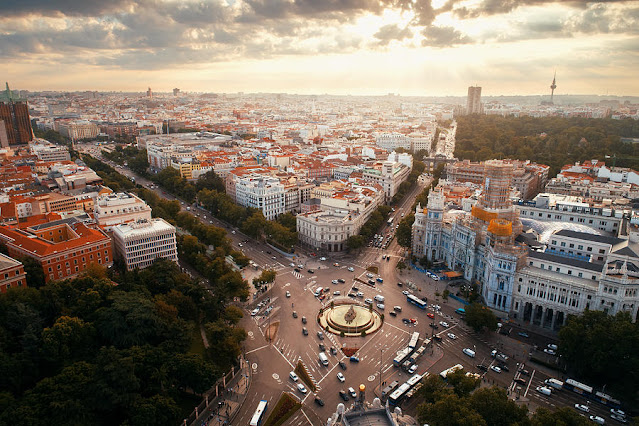

























.jpeg)





















._Casa_de_Alba.jpg)










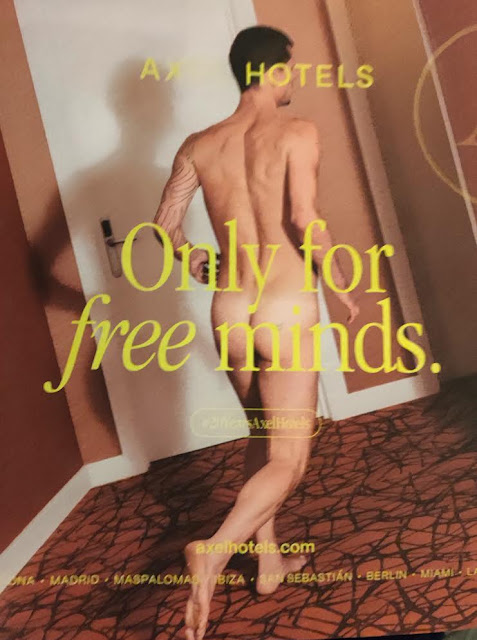




















.JPG)









































































.jpg)




.jpg)



























































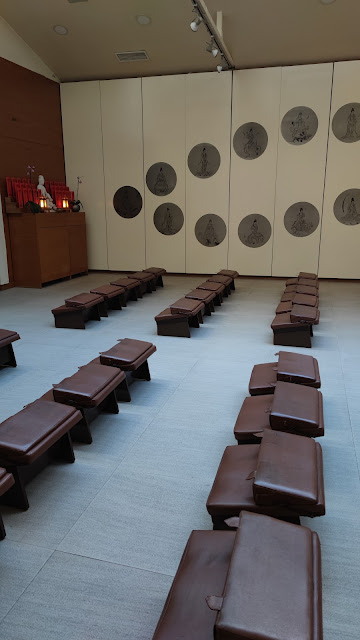











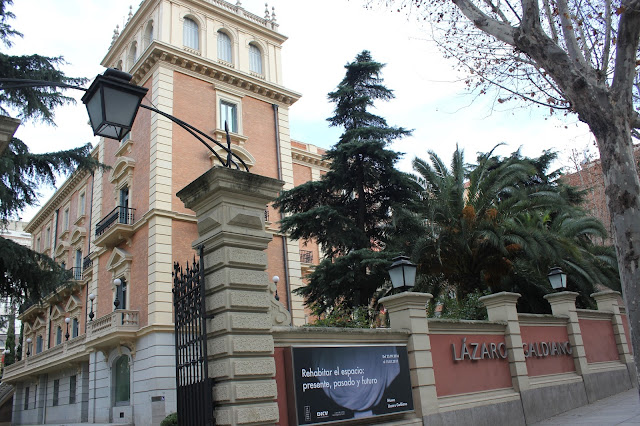
_04.jpg)


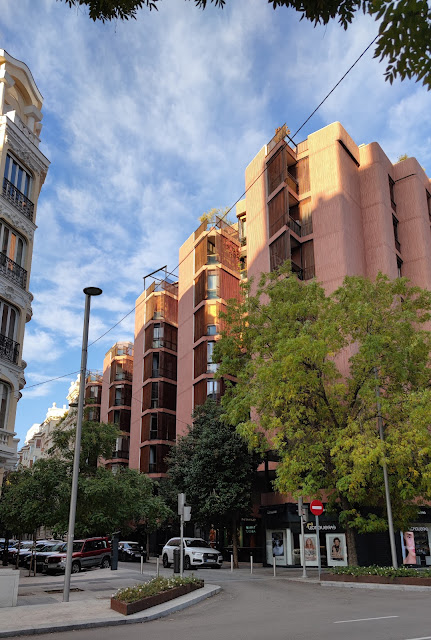














.svg.png)

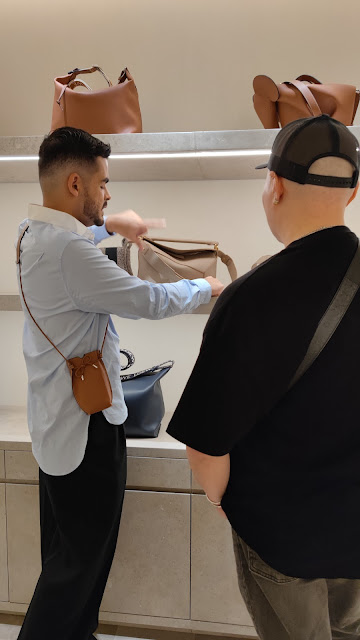
























































No comments:
Post a Comment
Don't be shy: leave your comments :)